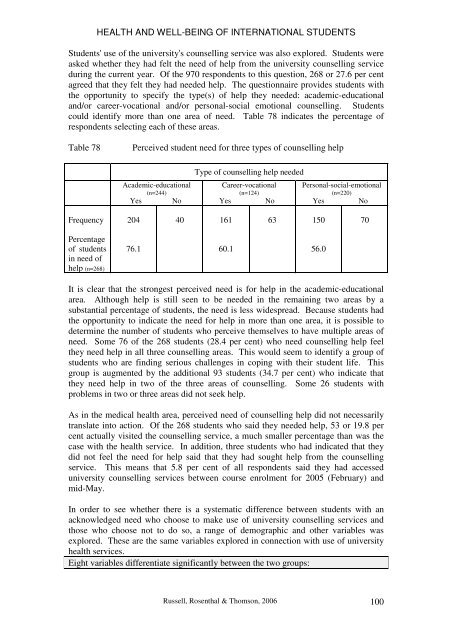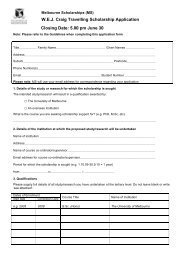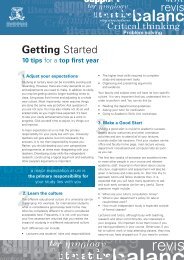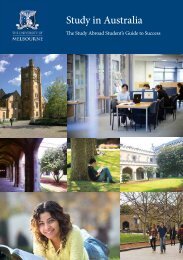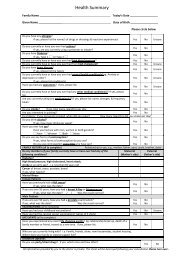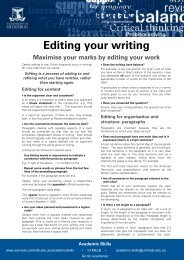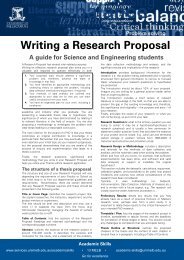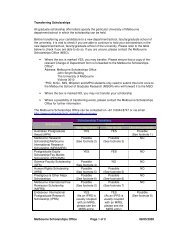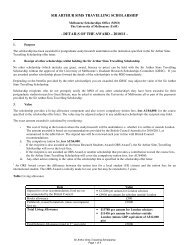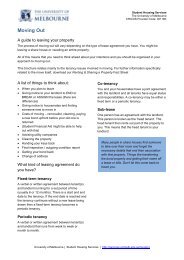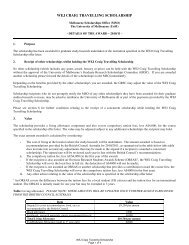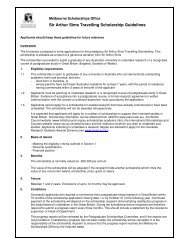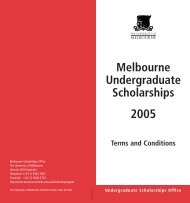a growing experience - Student Services - University of Melbourne
a growing experience - Student Services - University of Melbourne
a growing experience - Student Services - University of Melbourne
Create successful ePaper yourself
Turn your PDF publications into a flip-book with our unique Google optimized e-Paper software.
HEALTH AND WELL-BEING OF INTERNATIONAL STUDENTS<strong>Student</strong>s'use <strong>of</strong> the university's counselling service was also explored. <strong>Student</strong>s wereasked whether they had felt the need <strong>of</strong> help from the university counselling serviceduring the current year. Of the 970 respondents to this question, 268 or 27.6 per centagreed that they felt they had needed help. The questionnaire provides students withthe opportunity to specify the type(s) <strong>of</strong> help they needed: academic-educationaland/or career-vocational and/or personal-social emotional counselling. <strong>Student</strong>scould identify more than one area <strong>of</strong> need. Table 78 indicates the percentage <strong>of</strong>respondents selecting each <strong>of</strong> these areas.Table 78Perceived student need for three types <strong>of</strong> counselling helpAcademic-educational(n=244)Yes NoType <strong>of</strong> counselling help neededCareer-vocational(n=124)Yes NoPersonal-social-emotional(n=220)Yes NoFrequency20440 16163 15070Percentage<strong>of</strong> studentsin need <strong>of</strong>help (n=268)76.160.156.0It is clear that the strongest perceived need is for help in the academic-educationalarea. Although help is still seen to be needed in the remaining two areas by asubstantial percentage <strong>of</strong> students, the need is less widespread. Because students hadthe opportunity to indicate the need for help in more than one area, it is possible todetermine the number <strong>of</strong> students who perceive themselves to have multiple areas <strong>of</strong>need. Some 76 <strong>of</strong> the 268 students (28.4 per cent) who need counselling help feelthey need help in all three counselling areas. This would seem to identify a group <strong>of</strong>students who are finding serious challenges in coping with their student life. Thisgroup is augmented by the additional 93 students (34.7 per cent) who indicate thatthey need help in two <strong>of</strong> the three areas <strong>of</strong> counselling. Some 26 students withproblems in two or three areas did not seek help.As in the medical health area, perceived need <strong>of</strong> counselling help did not necessarilytranslate into action. Of the 268 students who said they needed help, 53 or 19.8 percent actually visited the counselling service, a much smaller percentage than was thecase with the health service. In addition, three students who had indicated that theydid not feel the need for help said that they had sought help from the counsellingservice. This means that 5.8 per cent <strong>of</strong> all respondents said they had accesseduniversity counselling services between course enrolment for 2005 (February) andmid-May.In order to see whether there is a systematic difference between students with anacknowledged need who choose to make use <strong>of</strong> university counselling services andthose who choose not to do so, a range <strong>of</strong> demographic and other variables wasexplored. These are the same variables explored in connection with use <strong>of</strong> universityhealth services.Eight variables differentiate significantly between the two groups:Russell, Rosenthal & Thomson, 2006 100


